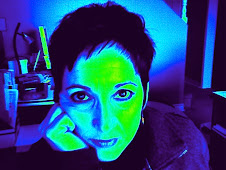I had a question from a visitor to Teacherscreech,(see comments under Why Don't Teachers...) and I thought I would talk a little about my training experiences and some reading that I have found invaluable.
I received a Bachelor of Education from the Institute of Child Development, in Saskatoon Saskatchewan. This was a special education wing of the Department of Education at the U. of S. that was piloted in the 70s and 80s. As far as I know it's not there anymore.
At the time it was a state of the art facility. Education students wanting to go into the field of special education spent the last two years of their degree at the Institute. My concentration of study was in language and learning disabilities. We had to do a practicum in speech development and another in learning disabilities, as well as our 3 months in a classroom. The Institute took clients from the community and we, the students, worked with these children under supervision of the department. We had to do clinical work in a room equiped with cameras and two way mirrors, so that our supervisors could watch and provide feedback. I felt prepared to work with special ed learners when I emerged with my B.Ed, but like most teachers I have talked to, I didn't really feel prepared to teach in a regular class until my first actual year in a classroom. I learned from my wonderful, patient peers!
I took further training in the Lindamood Phoneme Sequencing Program in '96. It was originally a speech and language program, but was revamped after it's utility in developing reading skills was discovered. It changed the way I work- indeed it was excellent training and provided very rewarding teaching experiences for me in the public system. I worked with another special ed teacher and we had a wonderful partnership for 9 years, and I still regard her as one of my closest friends.We used the Lindamood program with outstanding results. But- this is one of the reasons I Screech- we did a presentation to the School Board with pre and post test results on 12 students, and really, the results were clearly way out front of anything we had been able to achieve before and most likely better than any other special ed department. We suggested, in 1996, that the school district look into training more teachers. And the upshot is that nothing happened. Not for another 11 years! I have made several presentations to successive superintendents in special ed in our school district over the past 10 years (there has been considerable turnover in this department)- always offering to train teachers and help schools set up a Lindamood classroom. This yielded no results. But I digress...
Our district completed a half day workshop in this program in November 2007. I don't know how much one can absorb of this program in 1/2 a day, but I am relieved that now more students will start getting the evidence based support they need.
I then took several weeks of training over two successive summers at the teacher training facility at the Calgary Academy. This is a world class private school in Calgary Alberta, that has the latest and best technology, teaching methodology and teacher training. These guys really know what they are doing and do they ever get good results! The training facility is called Inlets, where they teach others their successful methods. I liked their work so much, and was ready for a change afer 18 years in the public system, that I became a limited partner with Calgary and started my own reading clinic, Planet Literacy.
I had been doing PL for about 6 years when I decided I needed to learn more about children with learning disabilities, so I went back and got my Masters Degree. It was during this time that I started reading seriously about the newest research.
Their are many researcher/writers who have written great papers and or books: Joseph Torgesen, Louisa Moats, Sally Shaywitz, and Marilyn Adams to name a few. There is a wonderful paper by Louisa Moats and Susan Brady, called Informed Instruction for Reading Success: Foundations for Teacher Preparation, that was officially approved as a Position Paper for the International Dyslexia Association in 1997. I don't know if it is available any more on the internet, but one could contact the Association. It is really thorough, and highlights the gaps that many of us in the field have witnessed.
Also, a book that I can't do without, is Overcoming Dyslexia by Sally Shaywitz, Published by Alfred A. Knopf 2003. The ISBN # is 0-375-40012-5. Another good book is The Voice of Evidence in Reading Research, by Peggy McCardle and Vinita Chhabra, publisher, Paul H Brooks, 2004, ISBN # 1-55766-672-5
For anyone wanting training is specific programs and methods for teaching reading:
In terms of training- I haven't seen it myself but I have seen students who have had Orton-Gillingham tutoring with good results. I think The O-G people have a comprehensive training program. Also, The Lindamood Phoneme Sequencing Program is very powerful, and has been around for years. (see comments above) and I believe they travel around the US with their training workshops. They have info on their website, www.lindamoodbell.com. There is something fairly new that is really getting good reviews is the SpellRead program. It is being marketed to school systems in the US, but I think it was created in Nova Scotia. (I'm a typical Canadian- have to point out EVERYTHING that is made in Canada!) LOL. A friend of mine who is a neuropsychologist thinks it's going to be big.
Subscribe to:
Post Comments (Atom)


3 comments:
Kathy,
Thank you for the valuable information you have listed in this post. I have taken notes and will be researching these programs and getting these books! Right now I have a few questions about the Lindamood Program.
I went to their website and researched the various programs that they offer. I am VERY interested in attending one of their workshops in Orlando, FL in March (just based on the results that you have explained here).
I see there is a "Phoneme Sequencing" (LiPs) and "Seeing Stars" both of which would be beneficial in my training. But if I had to choose one, which one would you recommend? I have a few learning disabled students that I am currently working with who have phonological processing difficulty (decoding is a BEAR for them). What I am doing with them is working and I am seeing progress (albeit slow) but as you said so well in your post, if it were my child it would not be enough! I want so much for these kids. Anyways, with limited funds I can only afford one class at this time - which one would benefit me the most?
Second question: You said in a post that the Lindamood method was notoriously difficult to learn but then later you said that you came back from the training and implemented it right away. Is this a program/training that can be learned quickly and implemented immediately without continued exposure and repeated practice to master?
Third question: From your experience in taking this training, what kind of background would be necessary in order to benefit from this training? Does one need to have a firm background in phonology, linguistics, and/or teaching methodology prior to attending a workshop or would someone (a parent) with very little training be able to benefit from this workshop as well.
Thanks again for your time and expertise. I appreaciate you.
Hi Lynda
Yes, my comment about starting right away after saying how complicated it was sounds a little confusing... the Lindamood Phoneme Sequencing Program is the LiPS one you mention as one of two choices you had to make. Let me explain. The LiPS program started out as the Auditory Discrimination in Depth (ADD!)program and came out in the 1960s. It was originally designed for speech problems. Quite a few schools up here in Canada had copies of it. By the time I started teaching in 1981, it had been sitting on the shelves of most of these schools gathering dust for several years. I saw it in the back cupboard in my room for several months before asking a visiting Speech Pathologist what it was. She told me, and added that a few teachers had attempted to use it but didn't really catch on to the way the manual was organized. In those days there was no training. I took that as a challenge! I took it home and read through the book and looked through the kit- then took it back the next day and put it back on the shelf!
The training is good, and once you go through it, and review your material, you can start- but for the first few weeks my partner and I scratched our heads alot, and kept going back into our notes. It was worth the effort. We used it with groups of up to 12 students (with two of us teachers working together) for three years before I left. My friend Lisa, still in the same school and the same position, still uses it today. We have developed a training package and have done a couple of trainings for student teachers. However, as I mentioned in another post, the demand up until this year has been "underwhelming".
If you pick one, I would definitely go with the LiPS first. I have often thought about doing some of the others, but so far I haven't had a need to do that.
For a really telling discussion about teachers' resistance to doing something different and out of their comfort zone, check out the Children of the Code series, the one called, (oddly) Resistance. This is what I call, "crazy making".
Post a Comment